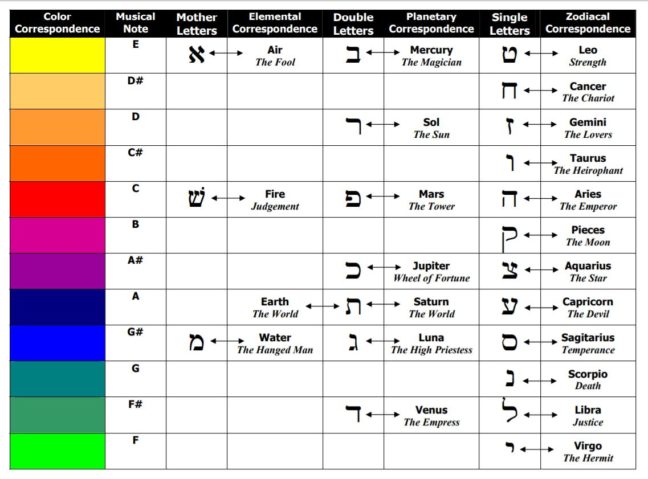Hidden symbols in Musical Art

As an artist, have you ever gone to great length to incorporate symbolism into your work, and realize later that almost no one is ever consciously aware of it? I think it is a pretty common occurrence among artists who intentionally employ symbolism. So I had this idea that I was going to do a little write up on tonal correspondences and time signature, and how we used them in The Rites of Eleusis for composition. At the end, we can talk about your art and methods you’ve employed if you like.
I have mentioned this process a few times over the years in talking about our work, and it is referenced in an earlier blog post with a little history, here:
Reading Rites Right

The above chart illustrates the various colors that correspond to the Hebrew letter paths on the Tree of Life, and the musical tones that correspond to those colors according to Allan Bennett’s Golden Dawn diaries.
These same correspondences are used by the Builders of the Adytum and in the writings of their founder, Paul Foster Case.
I remembered reading someone else had done a review with some details on this, so I did what anyone would do, and conducted a Google search.
What I found is the Richard Kaczynski review of the DVD release of The Rite of Mars from March 19th, 2015 on the Zero=Two Thelemic Blog:
Eleusyve Productions DVD Release Aleister Crowley’s The Rite of Mars
“When dealing with sacred names—as in a group performance of the Lesser Banishing Ritual of the Pentagram—the melody is dictated by the notes corresponding to those names. Thus, Adonai (אדני, ADNI or “Lord”) is sung to a melody using the notes E, F#, G, and F, while the name of the Archangel Gabriel (בריאל, GBRIAL) is sung using the notes G#, E, D, F, E, F#.”
– Richard Kaczynski, 0=2 March 19, 2015
Let me start by saying that this review stunned me when it was initially published (although it should not have, given Richard’s reputation for scholarly research and attention to detail) because it is the first time someone had written about the attention to detail we had incorporated into the composition without my having to explain it to them. It was a moment of pure joy for me to see that someone understood what we were up to!

And what we were up to is just as Richard described. Throughout our musical adaptations of The Rites of Eleusis, there are musical keys, scales, and phrases based upon these tonal correspondences that can be as simple as selecting the key of a tune, to the entire backing composition serving as the analysis of a God name. Time signatures are selected to represent the numerological significance of the beat. Themes for various characters are incorporated into the music, so that the theme of Saturn (2018) is heard when Saturn in Libra stalks the stage in The Rite of Venus (2007). The changing tides of the Rites is recorded in the changes within the musical score, but there is a continuity to the composition that runs throughout the entire cycle.
In addition, the color correspondences are included in the original scripts by Aleister Crowley, himself, as part of his vision for the Rites. We incorporated all of those into the costuming, lighting and sets.
The most obvious place where these tones are incorporated is the Lesser Ritual of the Pentagram.

The Lesser Ritual of the Pentagram appears in The Rite of Luna (2005), The Rite of Mars (2012) and The Rite of Saturn (coming later in 2019) and in each of these presentations, the music is performed in a slightly different style and cadence, but the primary tones are the same. The background music in all cases begins and ends with a series of chords constructed from the tones corresponding to letters of the Tetragrammaton and and name Adonai. All are composed in 3/4 time to capture the cadence of the opening A-Ta-He and closing A-Me-N of the Qabalistic Cross.
These are just some of the tools we used in crafting the music, but I share them in the hope that those of you who are looking for ways to incorporate this material into your work might find the method we employed useful, at least as a jumping off point.
When working in magick, or stagecraft, it is all about intentional application of symbols.
Anyone else have places where they weave more symbolism into their art than is apparent on the surface? We’d love to hear about it in the comments.
